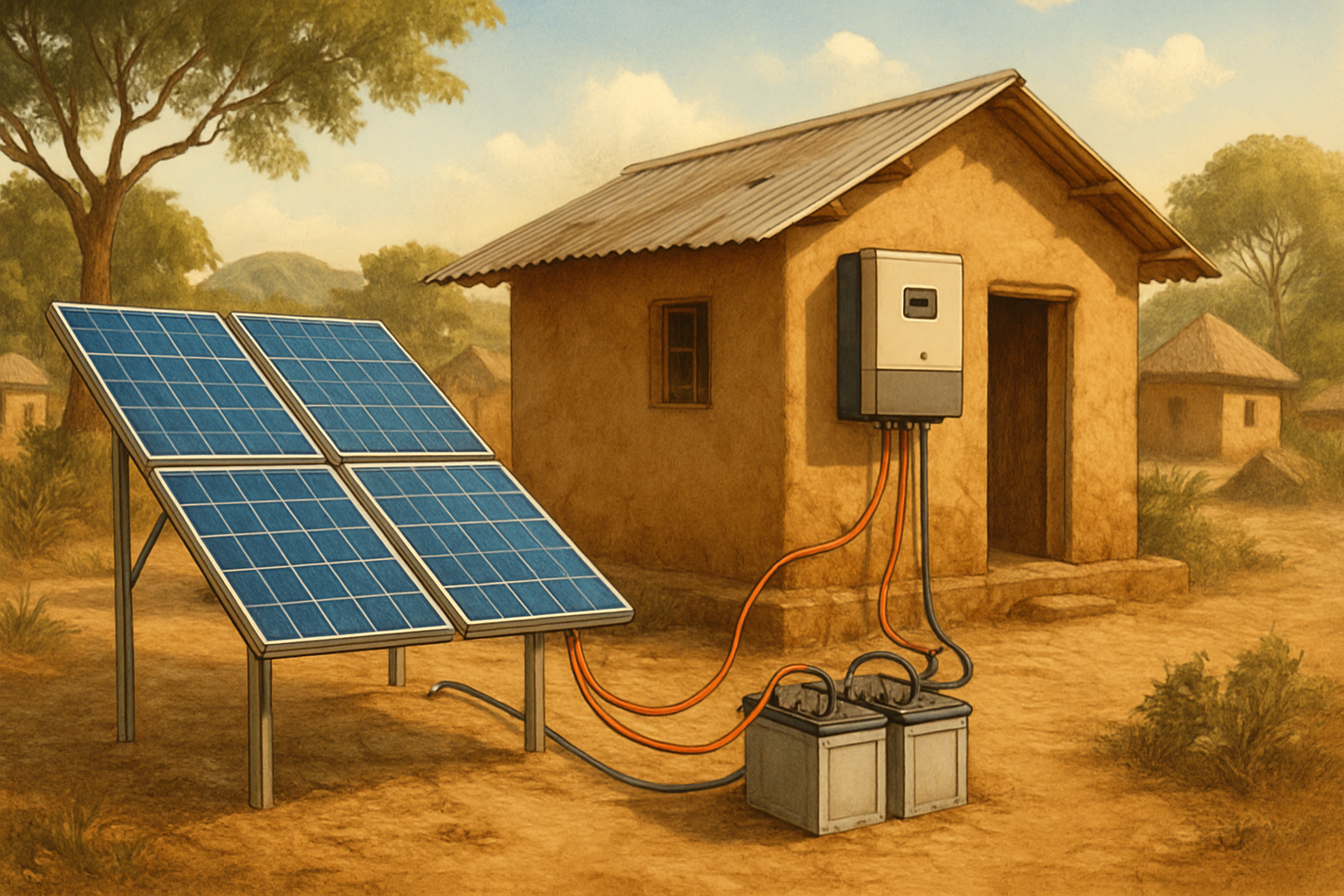Providing reliable electricity to remote villages presents a significant challenge. Many communities remain without access to stable power, hindering development and limiting opportunities. Off-grid microgrids, powered by solar energy and supported by advanced storage, offer a transformative solution. They deliver consistent, sustainable electricity, empowering communities and fostering economic growth.
Understanding Off-Grid Microgrids for Rural Electrification
Off-grid microgrids function as independent electrical networks, operating without a connection to a centralized utility grid. They are self-sufficient energy systems, designed to meet the specific power needs of a localized area, such as a village or a cluster of homes.
What is an Off-Grid Microgrid?
An off-grid microgrid typically integrates several key components:
- Solar Photovoltaic (PV) Panels: These convert sunlight into direct current (DC) electricity.
- Energy Storage Systems: Batteries store excess solar energy for use during periods of low sunlight or at night.
- Inverters: These devices convert the DC electricity from solar panels and batteries into alternating current (AC) electricity, suitable for household appliances and village infrastructure.
- Control Systems: Intelligent controllers manage power flow, optimize energy use, and ensure system stability.
- Backup Generators (Optional): In some designs, a diesel generator might provide supplementary power during extended periods of low solar production or high demand, though the aim is to minimize its use.
Microgrids, which are small electric grids with their own power sources, can operate independently from the main grid and deliver renewable energy, like solar, to strengthen community resilience during outages.
Why Microgrids for Remote Villages?
Extending traditional grid infrastructure to remote or geographically challenging areas is often prohibitively expensive and complex. Off-grid microgrids present a more viable and sustainable alternative:
- Economic Viability: While initial capital investment can be substantial, the operational costs of renewable microgrids (0.40-0.61 USD/kWh) are often significantly lower than diesel-based systems (0.92-1.30 USD/kWh) over their lifespan. This leads to long-term savings and predictable energy costs.
- Environmental Benefits: Utilizing solar power drastically reduces reliance on fossil fuels, cutting greenhouse gas emissions and local air pollution.
- Energy Independence and Reliability: Villages gain control over their energy supply, reducing vulnerability to grid outages or fuel supply disruptions. Microgrids in disaster-prone regions, such as Siesangtham in southeast Thailand, demonstrate enhanced resilience by disconnecting from the main grid during outages and ensuring continuity for critical loads through battery storage.
- Local Development: Reliable power supports education, healthcare, and stimulates local businesses, driving economic growth within the community. Approximately 18 million people in Southeast Asia still lack access to electricity, making renewable-based microgrids a sustainable solution.

Key Components and Technologies
The effectiveness of a village microgrid hinges on the careful selection and integration of its core technologies.
Solar Photovoltaic (PV) Systems
Solar panels are the primary energy source for most off-grid microgrids. Modern PV technology offers various options:
- Monocrystalline Panels: Known for high efficiency and sleek appearance, performing well in direct sunlight.
- Polycrystalline Panels: Generally more affordable, with slightly lower efficiency, but still robust.
- Thin-Film Panels: Flexible and lighter, suitable for diverse applications, though typically less efficient than crystalline types.
System sizing considers peak sun hours, daily energy consumption, and desired autonomy (days without sun). For example, a village requiring 100 kWh per day and having 4 peak sun hours would need a PV array capable of generating 25 kW during those hours, plus additional capacity for charging batteries and accounting for losses.
Energy Storage Solutions
Batteries are crucial for storing solar energy, ensuring power availability around the clock. Lithium iron phosphate (LiFePO4) batteries are a superior choice for microgrid applications due to their performance characteristics:
| Feature | LiFePO4 Batteries | Lead-Acid Batteries (for comparison) |
|---|---|---|
| Cycle Life | 3,000 to 6,000+ cycles (longer lifespan) | 500 to 1,500 cycles (shorter lifespan) |
| Depth of Discharge (DoD) | Up to 90-100% without significant degradation | Typically 50% recommended for longevity |
| Efficiency | High (90-99%) | Lower (70-85%) |
| Safety | Excellent thermal stability, low risk of thermal runaway | Can emit hydrogen gas, requires ventilation |
| Maintenance | Virtually maintenance-free | Requires regular watering (for flooded types) |
| Weight/Size | Lighter and more compact | Heavier and bulkier |
LiFePO4 batteries offer high performance, safety, and reliability, making them ideal for the demanding, long-term operation of village microgrids. Their longer lifespan and deeper discharge capabilities translate to a lower total cost of ownership.
Inverters and Control Systems
Inverters convert DC power to AC power, powering homes and businesses. For microgrids, hybrid inverters are common, managing power flow between solar panels, batteries, and loads. Advanced control systems are the "brain" of the microgrid:
- Power Management: Optimizes energy generation and consumption.
- Grid-Forming Capabilities: Grid-forming inverter technologies, often coupled with battery systems, are proven at mini-grid levels (from a few watts to tens of megawatts), offering reliable operations even in remote and demanding conditions for over a decade. These allow the microgrid to operate stably without an external grid reference.
- Fault Detection: Isolates issues to maintain overall system integrity.
- Remote Monitoring: Allows operators to track performance and troubleshoot remotely, reducing the need for on-site visits.
Designing a Robust Village Microgrid
A well-designed microgrid ensures long-term reliability and meets the community's energy needs effectively.
Load Assessment and Energy Demand Forecasting
The first step involves a thorough assessment of the village's energy requirements. This includes:
- Household Loads: Lighting, charging phones, small appliances.
- Productive Loads: Mills, water pumps, workshops, small businesses.
- Critical Loads: Healthcare clinics, schools, communication centers.
Accurate forecasting considers daily, weekly, and seasonal variations in demand, as well as future growth projections. This data directly informs the sizing of the PV array and battery bank.
System Sizing and Component Selection
Based on the load assessment, you can size the microgrid components:
- PV Array Sizing: Calculate the total solar panel wattage needed to cover daily energy consumption and recharge batteries. Consider local solar irradiance data.
- Battery Bank Sizing: Determine the required battery capacity (in kWh) to provide power during periods without solar input, typically for 1-3 days of autonomy, depending on criticality and weather patterns.
- Inverter Sizing: Select inverters with sufficient continuous power output to handle the village's peak simultaneous load.
Choosing high-quality, durable components is paramount for the longevity and reliability of an off-grid system in remote environments.
Installation Considerations and Maintenance
Proper installation and ongoing maintenance are vital for system performance:
- Site Preparation: Ensure stable ground for solar arrays, secure enclosures for batteries and inverters, and protection from environmental factors.
- Safety Protocols: Adhere to electrical safety standards during installation and operation.
- Remote Monitoring: Implement systems that allow for real-time performance tracking, fault alerts, and remote diagnostics. This reduces downtime and optimizes operational efficiency.
- Local Training: Empower local technicians with the skills to perform routine maintenance and basic troubleshooting. This fosters local ownership and ensures rapid response to minor issues.
Overcoming Challenges and Ensuring Sustainability
While off-grid microgrids offer immense potential, addressing specific challenges is key to their widespread adoption and long-term success.
Financial and Regulatory Frameworks
The upfront capital investment for renewable microgrids can be high, posing a barrier. However, innovative financing models can help:
- Grants and Subsidies: Government and international aid programs often provide initial funding.
- Pay-As-You-Go (PAYG) Models: These allow users to pay for electricity services in small, manageable installments, making energy access affordable.
- Impact Investment: Funds from socially conscious investors can bridge financing gaps.
Regulatory clarity and supportive policies are critical to attracting private investment. Policies like Indonesia’s "Accelerating Electrification in Rural Areas" promote rural microgrid deployment by creating frameworks that attract private investment and ensure grid compatibility.
Technical Resilience and Environmental Factors
Microgrids must withstand local environmental conditions. Island microgrids, for example, must withstand typhoons and high humidity, while inland systems face challenges from dense forests and mountainous terrain. Proper system design is crucial to ensure microgrids are resilient and fit for local environmental conditions. This includes choosing corrosion-resistant materials, designing for wind loads, and ensuring adequate ventilation for equipment.
Community Engagement and Local Capacity Building
Successful microgrid projects involve the community from the outset. Engaging local residents in the planning, implementation, and management phases fosters a sense of ownership. Providing training for local technicians ensures that the community can maintain and operate the system independently, promoting long-term sustainability.
Empowering Rural Futures
Off-grid microgrids represent a powerful tool for achieving energy independence and driving sustainable development in remote villages. By carefully planning, selecting robust technologies like LiFePO4 batteries and efficient solar panels, and addressing financial and technical challenges, you can create resilient energy systems. These systems do more than just provide electricity; they unlock opportunities, improve living standards, and build a brighter future for communities that have long been underserved.
Frequently Asked Questions
What is the typical lifespan of an off-grid village microgrid?
With proper design, high-quality components, and regular maintenance, a solar-plus-storage microgrid can operate reliably for 15-25 years. Solar panels often have a lifespan of 25+ years, while LiFePO4 batteries typically last 10-15 years or more, depending on usage and environmental conditions.
How can remote communities finance the initial cost of a microgrid?
Financing options include government grants, international development aid, impact investment funds, and innovative consumer-centric models like Pay-As-You-Go (PAYG) tariffs. These models help distribute the initial cost and make energy services accessible and affordable for villagers.
Are off-grid microgrids suitable for all remote villages?
Off-grid microgrids are highly suitable for most remote villages where extending the main grid is not economically feasible. Their applicability depends on factors like solar resource availability, community energy demand, and local environmental conditions. A detailed feasibility study helps determine the optimal solution for each specific location.





Leave a comment
All comments are moderated before being published.
This site is protected by hCaptcha and the hCaptcha Privacy Policy and Terms of Service apply.